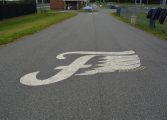Sight is the most obvious design guide. In a new landscape, the view of the finished garden is in the future when plantings mature. Since that will take some time, there should be a design for the present within the plan for the future. This is where most gardeners complicate things. I have brought so many plants home and stuck them in a nice empty sunny spot only to find years later that they are all distorted by overcrowding. Happily, the larger trees and shrubs are so established now that it is easy to see what to remove. Obviously, it would be easier and cheaper to anticipate than to remove. Annuals do a lot to help fill in for new areas. Also, pots which can be removed when the landscape grows, will hold the garden shape and continue to be useful elsewhere. Keep an eye on vertical sight lines as well as horizontal as shade will increase. Notice and plan for what will catch the corner of the eye with color or movement as this will tie the design together.
Fragrance, desirable and undesirable, also guides garden choices. Witch Hazel wafting across from the woods is nicer than right up at the door while pansies on a sunny stoop add fragrance without overwhelming. I prefer fragrant flowers to bloom consecutively rather than compete. Star magnolia first, then lilac, followed by spice viburnum, all bloom before my apples as I plant late varieties; Granny Smith, crispin, golden delicious, and winesap. In May, everything seems fragrant and I avoid planting very close to sitting areas as all manner of insects swarm around these honeypots.
While I don’t like to sit close to plants covered in bees, I do like to see them flying about and lighting on this and that, adding to the humming and buzzing sounds of the spring garden. Water gardens also add sound with peepers and water falling. Use this to block some less pleasant noise from the surrounding world. Water gardens encourage song birds to visit and stay with their cheerful calls and the beating swoosh of wings. I like the sound of a flagpole lanyard hitting the pole and the whipping snap of the flag itself reminds me of a harbor on a windy day. I have several kinetic yard ornaments which twirl, ring or clack, changing rhythm with the breeze.
Touch is a most personal sense which guides garden choices; some people really dislike prickly plants though they add character. Holly, mahonia, roses, quince, even the glorious Southern magnolia are nixed by timid touchers. Dawn redwoods and white pine feel soft despite looking like they have sharp needles and many love the feel of boxwood though the smell is distinct. Use Inkberry holly and the flat leaf chamaecyparis which are evergreen wihtout needles. Several perennials can add fuzzy appeal; rose campion, artimesia, lamb’s ears and pussy willow.
Last but not least is taste which we enjoy from early spring greens to the latest apple with all the fruits and vegetables in between; and a few throughout the winter. A small patch of thornless blackberries produces fruit that can be eaten fresh or frozen, made into jam or pie or moonshine! These bushes spread by layering and are hard to kill. Local paw paws along the river edge are wonderful but, for the home gardener, try ‘mango’ paw paw, or ‘Shenandoah, ‘Susquehanna’, or ‘Rappohannock’ varieties. For those who put up food, there is frozen, canned and stored produce to make our gardens linger. The midwinter taste of butternut squash soup with a hint of apples and herbs, recalls the previous season and anticipates the one to come.
© Fluvanna Review 2022. All rights reserved.
Produced by Valley Publishing Group




